Imagining a space where the luxurious appeal of a hotel meets the wild embrace of nature sets the stage for glamping. Picture waking up to the sun’s gentle rays streaming through wide tent flaps, surrounded by picturesque landscapes, while cozied up in plush bedding that promises the comfort of home. This isn’t your typical camping trip; it’s an experience where you’re not just surviving outdoors but thriving in style.
Choosing the right campsite is like picking the perfect stage for a performance. It can spell the difference between a magical getaway and a forgettable escape. Prioritize carefully! A stellar site that matches your taste in adventure and comfort is crucial. This makes the stars shine brighter, the campfire stories cozier, and every moment out there memorable.
When zoning in on your future glamping haven, several factors should enter the decision mix. Location is everything, just like in real estate. You want your glamping site to offer not only breath-taking views but also easy access, safety, and the right setup for gear and guest logistics. Think about how location affects your overall vibe and guest enjoyment.
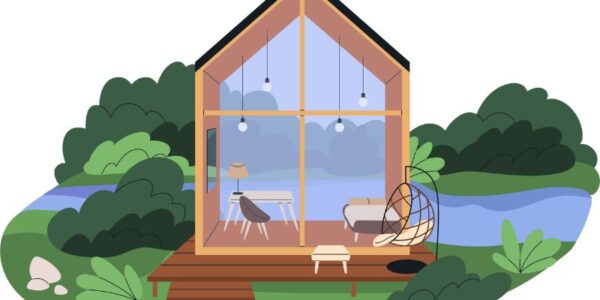
Finding the Ideal Location: Beauty Meets Accessibility
Finding the right spot is more than just setting up; it’s about connecting with the environment while keeping comfort in mind. Location plays a big role in your glamping experience, providing picturesque views and a slice of tranquility.
Proximity to water can add layers to your campsite experience. It might be ideal for cooking, washing, and enhancing the scenic vibe, but remember to set up at least 200 feet away from water sources to steer clear of floods or wildlife trying to join your meal!
The beauty of a site often comes with accessibility challenges. You want sweeping views of mountains or whispering woods nearby, but ensure the journey isn’t a trek from horror. Carrying glamping gear should feel like a peaceful stroll, not an odyssey.
Practicality is key. Look for spots offering ease of access to all guests. This doesn’t mean sacrificing the majestic views; it’s more about balance. A gorgeous lakeside or forest site that’s unreachable is hardly getaway gold.
Selecting the perfect location involves considering both aesthetic pleasure and logistical convenience. It’s about stepping out into nature without leaving comfort behind, ensuring each morning starts with unbeatable views and that setting camp doesn’t turn into an arduous task.
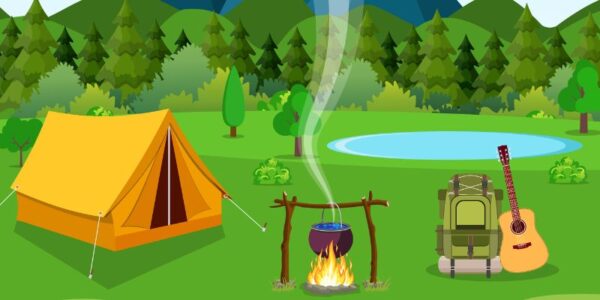
Campsite Layout: Strategic Arrangement for Safety and Functionality
The layout of your campsite is like designing a cozy living room in the great outdoors. The key is to keep everything functional yet stylishly arranged to maximize comfort and safety.
Think about tent placement first. Opt for flat, dry ground that naturally drains well—nobody likes a surprise waterbed in their tent! Orient your tent to face east to greet the morning sun while shielding yourself from strong winds. Getting that morning light can be a real vibe booster.
Safety is a big deal when setting campsites. Keep a good 10-15 feet between tents and fire setups. It avoids any accidental marshmallow-roasting infernos and gives everyone breathing room.
Convenience matters, so don’t be shy about organizing those creature comforts close at hand. Place common areas like seating and cooking spots thoughtfully, making them easy to navigate even in the dark.
Think about how everything flows—from the campfire to the tents and back to the seating zone. You want it all to feel like a natural loop, keeping everything hassle-free and fun-focused for all involved.
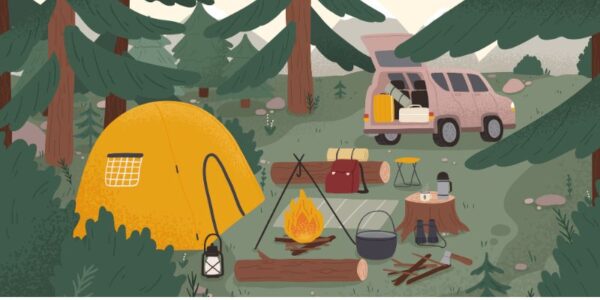
Setting Up the Perfect Camp Kitchen and Fire
Creating a camp kitchen and setting up a fire area are the heartbeats of any glamping site. A well-thought-out layout keeps adventure fun and meals exciting without the hazards.
First thing, always go for an existing fire pit if the site has one. It minimizes impact and keeps us greener. If you’re making one, set it at least 15 feet away from the tents. The idea is to enjoy the warmth without risking the safety of your tent or guests.
For cooking, designate an area specifically for setting up camp stoves. Portable stoves are the go-to—they’re safe and offer more control over those tantalizing camp meals. Keep this space away from sleeping zones to avoid unwanted midnight kitchen smells or wildlife encounters.
Plan the space thoughtfully so food prep, cooking, and eating areas flow naturally. It makes the experience smoother and way more enjoyable when you can grab a bite without going on an unintentional hike.
Keep eco-friendliness on the radar by using reusable utensils and sustainable kitchen tools. Keeping an organized kitchen space helps in packing out all waste, aligning with the Leave No Trace guidelines.
“What’s the Best Way to Start a Campfire?” find out at The Campers Collective!

Wildlife and Food Safety: Coexisting with Nature
Living close to nature comes with its set of responsibilities, especially when it comes to food safety and dealing with wildlife. Setting up camp in wild territory means sharing the space with creatures that got dibs on it first.
Storing food properly is your best defense against curious critters. Opt for bear-proof containers, or hang food at least 10 feet above ground and 200 feet from sleeping areas. This keeps four-legged visitors from wandering into your tents.
Embrace the ‘Leave No Trace’ principle. Packing out all waste is not just about cleanliness; it’s crucial for keeping wildlife safe and reducing pollution. Use biodegradable products wherever possible to lessen the impact on the environment.
Safety measures are essential—store scented items with food and keep bear deterrents handy. This isn’t about being paranoid, just keeping precautions in check so everyone can enjoy the adventure.
Educating your crew on these practices ensures a smooth glamping experience where your focus can stay on relaxation and nature appreciation, not on avoiding unexpected wildlife encounters.
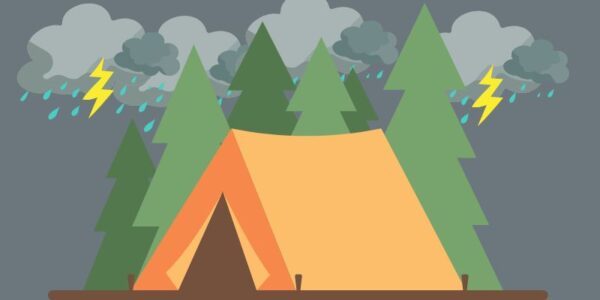
Embracing Weather: Adapt and Prepare
Getting in tune with local weather patterns is a top priority before setting up camp. It’s about staying safe and making the most of whatever Mother Nature throws your way, so always check the forecast before heading out to avoid surprise storms.
Choose your site wisely to avoid flood-prone zones or overly exposed areas. Those could turn a cozy getaway into a cold, wet misery you didn’t sign up for. Seeking natural features like tree cover can offer shade on hot days and shelter when the skies decide to open up.
Rain preparedness isn’t just about packing a raincoat. Make sure your tent’s got a quality rainfly and consider having tarps ready to create dry zones around the site. Staying dry means staying warm, which keeps those spirit levels high, rain or shine.
In summer, pick spots with ample shade to avoid overheating during the day. As the seasons change, adaptability ensures comfort, making those scenic vistas perfect for both dawn gazing and dusk lounging.
Staying weather-ready isn’t about fearing the elements but respecting and embracing them to enhance your glamping adventure. When you’re prepared, every weather shift adds to the memory bank, not the frustration file.
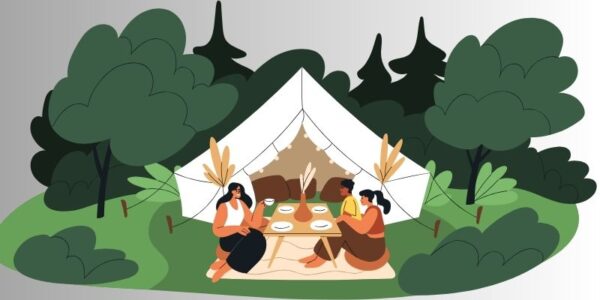
Elevating the Glamping Experience: Comfort with a Conscience
Think of glamping as camping’s more refined cousin—comfort is key, but so is responsibility towards nature. Crafting your perfect escape means balancing creature comforts with mindful practices that respect the environment.
Selecting the right ground is step one. Seek level surfaces for all your gear, be it luxe beds or cozy cots. This isn’t just about comfort but also ensuring a restful sleep without waking up on a slant or tangled in uneven ground.
Privacy doesn’t have to mean isolation. Natural barriers like trees or shrubs make excellent privacy screens without blocking the view, creating an intimate yet organic setting.
Lighting is essential, not just for ambience but safety. Solar-powered lights are a win—easy to use, eco-friendly, and just right for illuminating paths or highlighting the camp vibe.
Power needs might arise, so consider portable solar panels or battery packs. This way, gadgets can be charged, ensuring your group can stay connected or document those unforgettable moments, all without relying on non-renewable sources.
Sustainability should filter into every glamping detail, supporting local products and using eco-friendly gear. This nurtures not just your own experience but preserves those same untouched landscapes for future campers.
While comfort is king in glamping, weaving in eco-conscious elements ensures your footprint is light enough to keep the natural world thriving. It’s this respect that makes returning to the wild feel not just like a visit, but a responsible reunion.

Leave a Reply